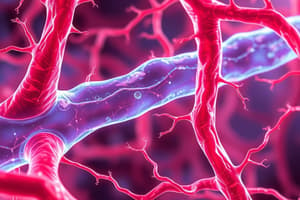Podcast
Questions and Answers
What is the role of valves in large veins?
What is the role of valves in large veins?
- To regulate blood pressure
- To facilitate nutrient exchange
- To prevent backflow of blood (correct)
- To assist in oxygenation of blood
How does blood in large veins primarily move toward the heart?
How does blood in large veins primarily move toward the heart?
- By contraction of smooth muscle fibers and external compressions (correct)
- By arterial pressure
- Due to negative pressure in the thoracic cavity
- Through direct nerve stimulation
Which layer of the large veins is typically thicker than the tunica media?
Which layer of the large veins is typically thicker than the tunica media?
- Tunica intima
- Tunica externa
- Tunica muscularis
- Tunica adventitia (correct)
What characterizes the tunica media of large veins?
What characterizes the tunica media of large veins?
Which statement correctly describes blood pressure in large veins?
Which statement correctly describes blood pressure in large veins?
What characteristic distinguishes elastic arteries from muscular arteries?
What characteristic distinguishes elastic arteries from muscular arteries?
Which diameter is typical for elastic arteries?
Which diameter is typical for elastic arteries?
What is the primary function of valves in veins and venules?
What is the primary function of valves in veins and venules?
How do venules compare to arterioles in terms of wall thickness?
How do venules compare to arterioles in terms of wall thickness?
What is a primary site for white blood cells to adhere to the endothelium?
What is a primary site for white blood cells to adhere to the endothelium?
What feature characterizes true arteries compared to veins?
What feature characterizes true arteries compared to veins?
Which statement about capillary beds is true?
Which statement about capillary beds is true?
Which option is most accurate about the muscle layers in small arteries?
Which option is most accurate about the muscle layers in small arteries?
What is the maximum diameter of muscular venules?
What is the maximum diameter of muscular venules?
Which component primarily comprises the wall structure of venules?
Which component primarily comprises the wall structure of venules?
What role do venules play in the immune response?
What role do venules play in the immune response?
Which layer of small or medium veins is characterized by small bundles of smooth muscle cells and a delicate network of elastic fibers?
Which layer of small or medium veins is characterized by small bundles of smooth muscle cells and a delicate network of elastic fibers?
How does the permeability of venules compare to other parts of the vascular system?
How does the permeability of venules compare to other parts of the vascular system?
What is the function of intercellular junctions within venules?
What is the function of intercellular junctions within venules?
What is the primary function of small or medium veins?
What is the primary function of small or medium veins?
How do the walls of venules compare to those of arterioles?
How do the walls of venules compare to those of arterioles?
What triggers venules to alter their permeability?
What triggers venules to alter their permeability?
What is primarily collected by venules from capillaries?
What is primarily collected by venules from capillaries?
Which component is more prevalent in the walls of muscular arteries compared to small or medium veins?
Which component is more prevalent in the walls of muscular arteries compared to small or medium veins?
What is the primary diameter range of immediate post-capillary venules?
What is the primary diameter range of immediate post-capillary venules?
What feature is often observed in sections of venules that is not typically seen in arterioles?
What feature is often observed in sections of venules that is not typically seen in arterioles?
Which layer in small or medium veins has a well-developed collagenous structure?
Which layer in small or medium veins has a well-developed collagenous structure?
What is the role of smooth muscle in arterioles?
What is the role of smooth muscle in arterioles?
Which characteristic defines small or medium veins in terms of size and location related to arteries?
Which characteristic defines small or medium veins in terms of size and location related to arteries?
What is the primary role of the smooth muscle found in the walls of veins?
What is the primary role of the smooth muscle found in the walls of veins?
Which statement about the adventitia of veins is true?
Which statement about the adventitia of veins is true?
What distinguishes the size of the muscular media layer in large veins compared to the adventitia?
What distinguishes the size of the muscular media layer in large veins compared to the adventitia?
In the structure of a vein, where are elastic fibers predominantly located?
In the structure of a vein, where are elastic fibers predominantly located?
What feature is typical of the lumen of large veins?
What feature is typical of the lumen of large veins?
Which of the following accurately describes the orientation of the smooth muscle layers in veins?
Which of the following accurately describes the orientation of the smooth muscle layers in veins?
What role do vasa vasorum play in the structure of veins?
What role do vasa vasorum play in the structure of veins?
Which layer of a vein is the thickest and contains longitudinal bundles of smooth muscle?
Which layer of a vein is the thickest and contains longitudinal bundles of smooth muscle?
Flashcards are hidden until you start studying
Study Notes
Venules
- Smallest veins, receiving blood from converging capillaries; diameters range from 10 microns (post-capillary venules) to 1 mm (muscular venules).
- Larger diameter than capillaries, consisting of endothelium and pericytes; features attenuated endothelium (0.2-0.4 μm wide).
- Endothelium is loosely organized and relatively leaky, facilitating material exchange between tissue fluid and blood.
- Functions include blood collection from capillaries, response to vasoactive agents (like histamine and serotonin), and facilitating the exit of white blood cells (WBCs) from blood into tissue.
- Venules act as primary sites for WBC adhesion during infection or tissue damage.
Small or Medium Veins
- Have diameters of 10 mm or less, located parallel to muscular arteries.
- Tunica intima features a thin subendothelial layer; tunica media consists of small smooth muscle bundles and elastic fibers.
- Tunica adventitia contains a well-developed collagenous layer.
- Main function is to collect blood from smaller venous vessels.
Large Veins
- Carry blood back to the heart from the microvasculature, operating under low pressure.
- Blood movement is aided by smooth muscle contractions in the media and external compressions from surrounding tissues.
- Valves, formed from the tunica intima, prevent backflow of blood.
- Tunica intima is well-developed, while the tunica media is thin with layers of smooth muscle and connective tissue.
- Tunica adventitia is thicker than the media, often containing longitudinal bundles of smooth muscle and vasa vasorum, supporting larger vessel structure.
Valves
- Valves in veins prevent the backflow of blood, ensuring unidirectional blood flow toward the heart.
- Located particularly at the entrances to the heart, such as the venae cavae and pulmonary veins, where a small amount of cardiac muscle is present in the adventitia.
Microscopic Features
- Venules have thinner walls and larger lumens compared to arterioles, allowing more space for red blood cells (RBCs) and WBCs.
- Veins often appear folded due to the thin muscular media compared to the thicker adventitia, which consists of dense irregular connective tissue.
Overall Functions of Veins
- Veins serve to transport deoxygenated blood back to the heart, managing low-pressure distribution and utilizing muscle contractions and valvular structures to maintain flow.
- Prioritization of leukocyte migration from bloodstream to tissues addresses immune responses during inflammation or injury.
Studying That Suits You
Use AI to generate personalized quizzes and flashcards to suit your learning preferences.


